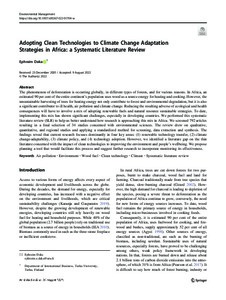Adopting Clean Technologies to Climate Change Adaptation Strategies in Africa: a Systematic Literature Review
Daka Ephraim
https://urn.fi/URN:NBN:fi-fe2022091258822
Tiivistelmä
The phenomenon of deforestation is occurring globally, in different types of forests, and for various reasons. In Africa, an estimated 90 per cent of the entire continent’s population uses wood as a source energy for heating and cooking. However, the unsustainable harvesting of trees for heating energy not only contribute to forest and environmental degradation, but it is also a significant contributor to ill health, air pollution and climate change. Reducing the resulting adverse of ecological and health consequences will have to involve a mix of adopting renewable fuels and natural resource sustainable strategies. To date, implementing this mix has shown significant challenges, especially in developing countries. We performed this systematic literature review (SLR) to help us better understand how research is approaching this mix in Africa. We screened 792 articles resulting in a final selection of 34 studies concerned with environmental sciences. The review drew on qualitative, quantitative, and regional studies and applying a standardized method for screening, data extraction and synthesis. The findings reveal that current research focuses dominantly in four key areas: (1) renewable technology transfer, (2) climate change-adaptability, (3) climate policy, and (4) technology adoption. However, we identified a literature gap on the thin literature concerned with the impact of clean technologies to improving the environment and people’s wellbeing. We propose planning a tool that would facilitate this process and suggest further research to incorporate monitoring its effectiveness.
Kokoelmat
- Rinnakkaistallenteet [19207]
